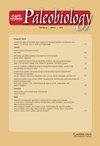Understanding the appearance of heterospory and derived plant reproductive strategies in the Devonian
IF 2.7
2区 地球科学
Q2 BIODIVERSITY CONSERVATION
引用次数: 2
Abstract
Abstract. The evolution of different spore size classes, or heterospory, is a fundamental reproductive innovation in land plants. The appearance of heterospory is particularly notable during the Devonian, when most known origins of the trait occur. Here we provide a perspective on the evolution of heterospory during this time interval, particularly from the late Early Devonian through the Middle Devonian (Emsian to Givetian Stages; 408–383 Ma), which shows an unusually high concentration of heterospory origins. We use theoretical considerations and compilations of fossil and extant spore sizes to suggest that the basic features of most heterosporous lineages, large spores and gametophytes that mature within the spore wall, are difficult to evolve in combination, because large spores disperse poorly but small spores cannot support a functional gametophyte developing within their walls; evolving spores between 100 and 200 microns in diameter appears to represent a particularly important barrier for the evolution of heterospory. We then discuss why this barrier may have been lower in the Devonian, noting that the appearance and spread of heterospory is coincident with the emergence of peat-accumulating wetland habitats. We suggest that more widespread wetland habitats would have generally lowered barriers to the evolution of heterospory by reducing dispersal limitation in larger spores. Ultimately, we suggest that the initial evolution of heterospory may be explained by major changes in sedimentology, thought to have been driven by plant evolution itself, that increased the diversity of terrestrial depositional environments and led to a greater number of habitats where large spores could be successful.了解泥盆纪异孢子虫的出现及其衍生的植物繁殖策略
摘要不同孢子大小类别或异孢子的进化是陆地植物繁殖的一项基本创新。异胞体的出现在泥盆纪尤为显著,当时大多数已知的异胞体起源都发生了。在这里,我们提供了一个关于这一时间间隔内异孔体进化的视角,特别是从早泥盆纪晚期到中泥盆纪(埃姆西阶到吉维阶;408–383 Ma),这表明异孔体起源异常集中。我们利用化石和现存孢子大小的理论考虑和汇编表明,大多数异孔谱系的基本特征,即在孢子壁内成熟的大孢子和配子体,很难组合进化,因为大孢子分散性差,但小孢子无法支持在其壁内发育的功能性配子体;直径在100到200微米之间进化的孢子似乎代表了异孢子进化的一个特别重要的障碍。然后,我们讨论了为什么泥盆纪的这一屏障可能更低,注意到异孢子的出现和传播与泥炭堆积湿地栖息地的出现相吻合。我们认为,更广泛的湿地栖息地通常会通过减少较大孢子的传播限制来降低异孢子进化的障碍。最终,我们认为,异孢子的最初进化可以用沉积学的重大变化来解释,沉积学被认为是由植物进化本身驱动的,这增加了陆地沉积环境的多样性,并导致了更多大孢子可以成功繁殖的栖息地。
本文章由计算机程序翻译,如有差异,请以英文原文为准。
求助全文
约1分钟内获得全文
求助全文
来源期刊

Paleobiology
地学-古生物学
CiteScore
5.30
自引率
3.70%
发文量
38
审稿时长
>12 weeks
期刊介绍:
Paleobiology publishes original contributions of any length (but normally 10-50 manuscript pages) dealing with any aspect of biological paleontology. Emphasis is placed on biological or paleobiological processes and patterns, including macroevolution, extinction, diversification, speciation, functional morphology, bio-geography, phylogeny, paleoecology, molecular paleontology, taphonomy, natural selection and patterns of variation, abundance, and distribution in space and time, among others. Taxonomic papers are welcome if they have significant and broad applications. Papers concerning research on recent organisms and systems are appropriate if they are of particular interest to paleontologists. Papers should typically interest readers from more than one specialty. Proposals for symposium volumes should be discussed in advance with the editors.
 求助内容:
求助内容: 应助结果提醒方式:
应助结果提醒方式:


